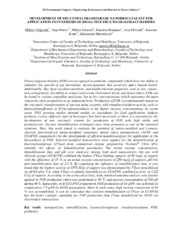Приказ основних података о документу
DEVELOPMENT OF FRUCTOSYLTRANSFERASE NANOBIOCATALYST FOR APPLICATION IN SYNTHESIS OF BIOACTIVE FRUCTO-OLIGOSACCHARIDES
| dc.creator | Veljković, Milica | |
| dc.creator | Petrov Ivanković, Anja | |
| dc.creator | Simović, Milica | |
| dc.creator | Banjanac, Katarina | |
| dc.creator | Mitrušić, Ana | |
| dc.creator | Katić, Katarina | |
| dc.creator | Marinković, Aleksandar | |
| dc.date.accessioned | 2023-03-09T07:25:25Z | |
| dc.date.available | 2023-03-09T07:25:25Z | |
| dc.date.issued | 2021 | |
| dc.identifier.isbn | 978-99955-81-40-4 | |
| dc.identifier.uri | http://TechnoRep.tmf.bg.ac.rs/handle/123456789/5998 | |
| dc.description.abstract | Fructo-oligosaccharides (FOS) are recognized as prebiotic compounds which have the ability to stimulate the growth of gut microbiota, microorganisms that positively affect human health. Additionally, they have excellent nutrition- and health-relevant properties such as low caloric, non-cariogenicity, the ability to reduce total serum cholesterol levels, and many others. FOS can be found in various vegetables and fruits, but in low concentrations, which represents the main reason for their production on an industrial level. Production of FOS is predominantly based on the enzymatic transformation of sucrose using enzymes with transfructosylation activity such as fructosyltransferases or β-fructofuranosidases at the higher sucrose concentrations. In recent years, FOS growing market demand mainly as ingredients for food applications (bakery products, sweets, different types of beverages) has been increased, so there is a necessity for the development of new enzymatic systems for production of FOS with high yields and productivities. Enzyme immobilization techniques have been proposed as one of the potential solutions. Thus, this work aimed to evaluate the potential of amino-modified and cyanuric chloride functionalized amino-modified nonporous fumed silica nanoparticles (AFNS and CCAFNS, respectively) for the development of efficient nanobiocatalysts for application in the biosynthesis of FOS. Selected modified nanocarriers were applied for the immobilization of fructosyltransferase (FTase) from commercial enzyme preparation Pectinex® Ultra SP-L whereby the effects of immobilization parameters like initial enzyme concentration, immobilization time and pH were analysed. Among both used nanocarriers, the one with chloride groups (CCAFNS) exhibited the highest FTase binding capacity of 89 mg/g of support with the efficiency of 35 % at an initial enzyme concentration of 250 mg/g of support, pH 6.0, and immobilization time of 2.5 h. By examining the influence of immobilization time, it was found that the highest activity of 1576 IU/g of support was demonstrated by FTase immobilized on AFNS after 5 h, while FTase covalently immobilized on CCAFNS, exhibited activity of 1122 IU/g of support. According to the achieved activity, both obtained nanobiocatalysts were further applied in FOS production which was performed at 50 ⁰C and sucrose concentration of 500 g/l during 48 h. Apparently, with CCAFNS preparation FOS production of 14 g/l/h was achieved as compared to 5.9 g/l/h by AFNS preparation. Since in both cases, high sucrose conversion of 89 % was accomplished, it can be concluded that covalent immobilization of FTase on CCAFNS has the better catalytic capability for FOS production than FTase immobilized on AFNS via electrostatic interactions. | sr |
| dc.language.iso | en | sr |
| dc.publisher | Faculty of Technology, University of East Sarajevo | sr |
| dc.relation | info:eu-repo/grantAgreement/MESTD/inst-2020/200287/RS// | sr |
| dc.rights | openAccess | sr |
| dc.rights.uri | https://creativecommons.org/licenses/by/4.0/ | |
| dc.source | VII International Congress “Engineering, Environment and Materials in Process Industry“ | sr |
| dc.subject | nanoparticles | sr |
| dc.subject | immobilization | sr |
| dc.subject | fructosyltransferase | sr |
| dc.subject | transfructosylation | sr |
| dc.subject | FOS | sr |
| dc.subject | prebiotics | sr |
| dc.title | DEVELOPMENT OF FRUCTOSYLTRANSFERASE NANOBIOCATALYST FOR APPLICATION IN SYNTHESIS OF BIOACTIVE FRUCTO-OLIGOSACCHARIDES | sr |
| dc.type | conferenceObject | sr |
| dc.rights.license | BY | sr |
| dc.citation.spage | ENG-32 | |
| dc.identifier.doi | 10.7251/EEMEN2101314V | |
| dc.identifier.fulltext | http://TechnoRep.tmf.bg.ac.rs/bitstream/id/15915/bitstream_15915.pdf | |
| dc.type.version | publishedVersion | sr |

